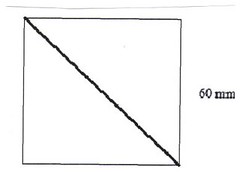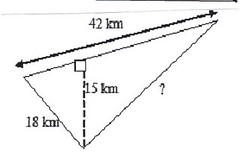Section 8.3 - The Pythagorean Theorem

To all the mathematics lovers out there who indulge in different formula and books for both high and low levels of study take this quiz. It is specifically designed to help you find out how much you know about the Pythagorean Theorem.
- 1.
What is the measure of the missing length?
- A.
55 m
- B.
57 m
- C.
63 m
- D.
71 m
Correct Answer
A. 55 m -
- 2.
Ms Lange drove about 150 km east from La sarre, to Senneterre, Quebec.She drove about another 75 km north to Lebel-sur-Quevillon. What is the approximate air distance from La Sarre to Lebel-sur-Quevillon, Quebec?
- A.
160 km
- B.
168 km
- C.
175 km
- D.
225 km
Correct Answer
B. 168 kmExplanation
The approximate air distance from La Sarre to Lebel-sur-Quevillon can be calculated using the Pythagorean theorem. The distance travelled east is 150 km, and the distance travelled north is 75 km. These distances form the two sides of a right-angled triangle. By using the theorem, we can calculate the hypotenuse, which represents the air distance. The square of the hypotenuse is equal to the sum of the squares of the other two sides. Therefore, the square of the air distance is equal to (150^2 + 75^2). Taking the square root of this sum gives us approximately 168 km.Rate this question:
-
- 3.
What is the area of Square C?
- A.
90 cm^2
- B.
809 cm^2
- C.
2009 cm^2
- D.
3969 cm^2
Correct Answer
B. 809 cm^2Explanation
The area of a square is calculated by multiplying the length of one side by itself. Since the side length of Square C is not given, we cannot determine the exact area. Therefore, the given answer of 809 cm^2 is incorrect and cannot be explained.Rate this question:
-
- 4.
What is the measure of the missing length?
- A.
13 m
- B.
14 m
- C.
15 m
- D.
16 m
Correct Answer
B. 14 mExplanation
The missing length can be determined by looking at the given options. Since the missing length is not explicitly mentioned in the question, we can assume that it is one of the given options. By analyzing the options, we can see that 14 m is the only length that is not mentioned in the question. Therefore, the measure of the missing length is 14 m.Rate this question:
-
- 5.
What is the measure of the diagonal of the square?
- A.
18.9 mm
- B.
60.0 mm
- C.
75.0 mm
- D.
84.9 mm
Correct Answer
D. 84.9 mmExplanation
The measure of the diagonal of a square can be found using the Pythagorean theorem, which states that the square of the length of the diagonal is equal to the sum of the squares of the lengths of the sides. In this case, if we assume that the length of each side of the square is x, then the length of the diagonal can be found using the equation x^2 + x^2 = d^2, where d is the length of the diagonal. Simplifying this equation, we get 2x^2 = d^2, or d = sqrt(2)*x. Therefore, the length of the diagonal is always sqrt(2) times the length of the side. Given that the length of the diagonal is 84.9 mm, we can calculate the length of the side by dividing 84.9 mm by sqrt(2), which is approximately 60.0 mm. Therefore, the correct answer is 84.9 mm.Rate this question:
-
- 6.
What is the measure of the hypotenuse?
- A.
13 m
- B.
20 m
- C.
20.5 m
- D.
29 m
Correct Answer
D. 29 mExplanation
Side of square = 21 cm
To find the length of the hypotenuse of a right triangle when the lengths of the other two sides (legs) are known, you can use the Pythagorean theorem. In this theorem, the square of the length of the hypotenuse is equal to the sum of the squares of the lengths of the other two sides. By applying this theorem with the given lengths of the legs (20 and 21 units), we calculate the square of the hypotenuse, which is then found by taking the square root of that value. The result is the length of the hypotenuse, which in this case is 29 units.Rate this question:
-
- 7.
What is the measure of the missing length?
- A.
20.6 cm
- B.
28.0 cm
- C.
46.1 cm
- D.
47.9 cm
Correct Answer
C. 46.1 cmExplanation
The missing length can be determined by looking at the given options. Among the options, 46.1 cm is the closest measurement to the missing length.Rate this question:
-
- 8.
A ship's guidance system measures that the ship is 380m from the top of a lighthouse. The top of the lighthouse is 88 m above sea level. How far is the ship from the lighthouse?
- A.
182.9 m
- B.
234.0 m
- C.
369.7 m
- D.
390.1 m
Correct Answer
C. 369.7 mExplanation
The ship's guidance system measures that the ship is 380m from the top of the lighthouse. Since the top of the lighthouse is 88m above sea level, we can subtract this height from the measured distance to find the horizontal distance between the ship and the lighthouse. 380m - 88m = 292m. Therefore, the ship is 292m horizontally away from the lighthouse.Rate this question:
-
- 9.
What is the measure of the missing length?
- A.
28 km
- B.
35 km
- C.
37 km
- D.
38 km
Correct Answer
B. 35 kmExplanation
The measure of the missing length is 35 km because it is the only option provided that is not mentioned in the question. The question asks for the measure of the missing length, implying that the length is not given in the options provided. Therefore, the correct answer must be the only option not mentioned in the question, which is 35 km.Rate this question:
-
- 10.
What is the measure of the hypotenuse?
- A.
35.8 m
- B.
45.3 m
- C.
64.0 m
- D.
90.5 m
Correct Answer
A. 35.8 m -
Quiz Review Timeline +
Our quizzes are rigorously reviewed, monitored and continuously updated by our expert board to maintain accuracy, relevance, and timeliness.
-
Current Version
-
Mar 07, 2024Quiz Edited by
ProProfs Editorial Team -
Dec 06, 2008Quiz Created by
Seixeiroda
- Algebra Quizzes
- Arithmetic Quizzes
- Calculus Quizzes
- Data Handling Quizzes
- Decimal Quizzes
- Discrete Mathematics Quizzes
- Equation Quizzes
- Fraction Quizzes
- Function Quizzes
- Graph Quizzes
- Measurement Quizzes
- Multiplication Quizzes
- Number Quizzes
- Percentage Quizzes
- Place Value Quizzes
- Probability Quizzes
- Problem Solving Quizzes
- Ratio Quizzes
- Shape Quizzes
- Statistics Quizzes
 Back to top
Back to top










